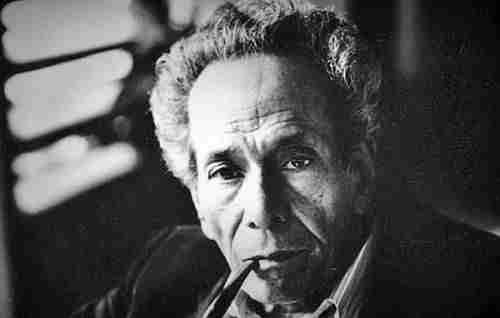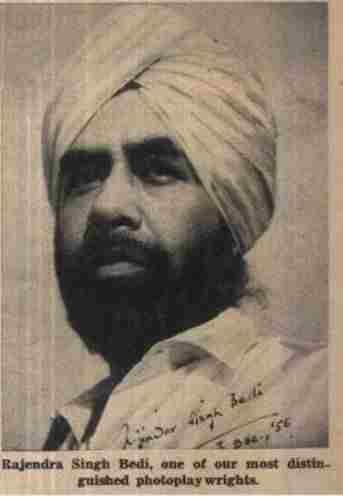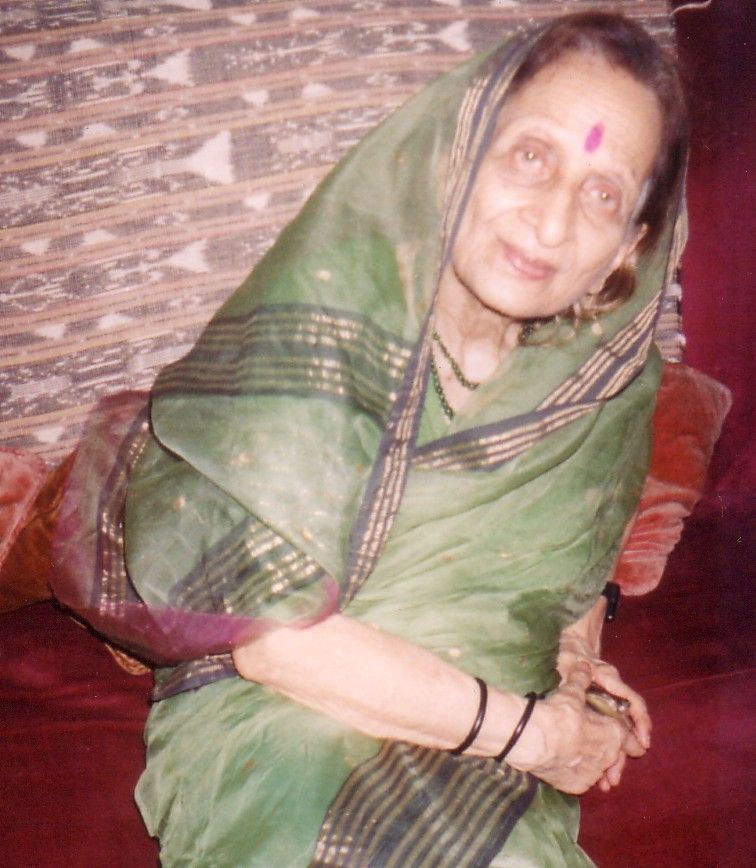There was a time when people connected with films were not viewed agreeably. Times changed, cinema's power and importance transformed the perception of the society, educated people from respectable families started to gradually incline towards films and then with the passing of time, cinema became a flourishing industry in itself. But even today, where the common man's perception of the women associated with films is concerned, not much has changed. At the outset, the women in films would, as a rule, come from families with song and dance backgrounds but, there were also some educated girls from good families who were exceptions to the rule like Durga Khote and Leela Chitnis who despite all the opposition from their families and society carved their future in cinema on the basis of their talent, diligence and hard work and engraved their names in golden letters in the history of cinema. Amongst these, one was Vanmala who forayed into Hindi cinema with Sohrab Modi's film Sikandar (1941) but due to contrived circumstances after a brief career of 13 years and despite amassing all possible fame, she had to bid farewell to the glitz and glamour of the cinematic world. Made in 1953 the Marathi film Shyamchi Aai, also the recipient of the first President's Award, was Vanmala's last film after which she went to Vrindavan and immersed herself in lords service and social work.
Vanmala's father Colonel Raobahadur Bapurao Anandrao Pawar other than being Malwa States collector and Shivpuri's commissioner at that time was also a member of the trust set up by Gwalior's king Madhav Rao Scindia before his untimely death to look after his estate. Vanmala was born on 23 May 1915 in Ujjain and was brought up on Gwalior estate in royal fashion. She was schooled in horse riding, swimming, marksmanship, polo, and fencing since childhood. She completed her initial education in Sardar Daughters School, a school especially for the children of the royal family after which she received her B.A. degree from Gwalior itself. Thereafter she went to Mumbai and enrolled herself for M.A. But in 1935, due to her mother's sudden demise, she left her studies midway and returned to Gwalior.

Vanmala's entry into films was a sheer coincidence. During a meeting, she had said that “My Mother's sister used to live in Pune and was the principle in Agarkar High School which was run by Marathi writer and theater personality Acharya Atre. After spending some time in Gwalior I went to live with my aunt in Pune and I too started teaching at Agarkar High School. While in Pune I also completed my B.T. Through Acharya Atre, I met renowned filmmakers like V. Shantaram, Master Vinayak, and Baburao Pendharkar. V. Shantaram wanted to keep me as an assistant director with him, an offer which I declined. But when all these film personalities insisted that I play the heroine in Marathi film Lapandav (the game of hide & seek), I just could not refuse.”

Released in 1940, Lapandav was actress Nanda's father Master Vinayak's Kolhapur based company Navyug Chitrapat's film. According to Vanmala, she met Sohrab Modi at film Lapandav's premier who at that time was searching for a new face for the lead role of Rukhsana in the film Sikandar (1941). Impressed with Vanmala's performance in Lapandav, Sohrab Modi chose Vanmala to essay the role of Rukhsana. Released in 1941, film Sikandar's male lead was Prithviraj Kapoor, composer was Mir Sahab and Rafiq Ghaznavi, and writer-lyricist was Pandit Sudarshan. This is the same Pandit Sudarshan whose novella Haar ki Jeet is still considered a milestone in Hindi literature. Sikandar proved to be a big hit at that time and its tremendous success propelled Vanmala into stardom. But Vanmala's foray into films was objected to heavily at a social and familial level and her father cut off all ties with her and he barred her from coming to Gwalior.

After Sikandar, Vanmala did about 22 Hindi films like Charno Ki Daasi (with Avinash, 1941), Vasasntsena (Sahu Modak, 1942), Raja Rani (Trilok Kapoor, 1942), Muskurahat (Motilal, 1943), Shahenshah Akbar (Kumar, 1943), Dil Ki Baat (Ishwarlal, 1944), Kadambari (1944) and Mahakavi Kalidas (Pahadi Sanyal, 1944), Parbat Par Apna Dera (1944) and Suno Sunata Hoon (Ulhas, 1944), Sharbati Ankhein (Ishwarlal, 1945), Parinde (1945) and Aarti (Surendra, 1945), Khandani (Kumar,1947), Chandrahaas (Prem Adib, 1947), Beete Din (Motilal, 1947), Pehla Pyar (aghajaan, 1947) and Azadi Ki Raah Par (Prithviraj Kapoor, 1948) and 10 Marathi films as a heroine. She sang songs for herself in a few films like Vasasntsena (1942), Raja Rani (1942), Dil Ki Baat (1944) and Aarti (1945). In keeping with her educational qualifications at that time, during film publicity, her name used to appear as Vanmala B.A.B.T. As a partner of Atre Pictures other than films like Charno Ki Daasi (1941), Vasasntsena (1942), Raja Rani (1942), Dil Ki Baat (1944), Tasveer (1943), Parinde (1945) and Khandani (1947) she also produced some Marathi films. One of the movies made under the banner of Atre Pictures was the Marathi film Shyamchi Aai which was based on the famous Marathi writer Sane Guruji's novel and it received the first President Award in 1953 by Dr. Rajendra Prasad. Other than being the co-producer for the film, Vanmala also portrayed the part of Shyamchi Aai meaning Shyam's Mother. According to Vanmala her father's resentment towards her hadn't subsided as yet and had become a fair cause of concern for her father's friends namely Gwalior's King Jivaji Rao Scindia and Gujrat's Sachin estate's Nawab Hyder Ali. After his friend's counsel, Vanmala's father forgave her but according to his condition, Vanmala left the film industry forever. And just like that Shyamchi Aai proved to be Vanmala's last film and she returned to Gwalior, however, her film Angaare was released in 1954 after she left Mumbai which can be considered her last released film.

According to Vanmala, she had inherited her religious and spiritual values from her parents. As atonement, she had to accompany her father to a pilgrimage to Badrinath Dham after which she started spending a maximum of her time at the temples in Mathura-Vrindavan. According to her along with prayer and worship, circling Govardhan had become a part of her daily routine. When she was in Mumbai, other than films, she would also participate in dramas with Durga Khote. From the income acquired from dramas, the two actresses founded the famous Marathi Sahitya Sangh Auditorium at Grant Road. Despite staying in Mathura, Vanmala couldn't resist her fascination with art. Other than assuming the posts of trustee of Shiv Mudra Pratishthan Chaitanyalaya Trust and the post of president for Braj Kala Kendra Mathura, she also founded the Swami Haridas Kala Sansthan at Vrindavan and Govardhan. Associated with Lucknow's Bhatkhande University, this school would provide dance and music lessons to children at a very nominal fee.

Vanmala had given up not only Cinema but also materialistic pleasures and had retired as a hermit and came to be known as Sushila Bai in Mathura-Vrindavan. She spent the last 3 years of her life predominantly living with her sister Sumati Devi Dhanvate at the latter's home in Mumbai's Mahalaxmi area. Sumati Devi was married to Maruti Rao, son of Dada Saheb Dhanvate who was the owner of the biggest printing press in Asia called Shivraj Fine Arts Litho Works which was based in Nagpur. In 2003, on the golden jubilee of the making of Shyamchi Aai, Maharashtra government made a documentary on Vanmala. At the same time, Mumbai based Dada Saheb Phalke Academy honored her for Outstanding services and achievements in the field of cinema. After a long fight with illness, Vanmala passed away at the age of 92 on 29 May 2007 in Gwalior.

Image Courtesy: Beete Hue Din
It has been 5 years since Vanmala's death, but her name has been etched in the history of Hindi and Marathi Cinema forever. It is very rare to see such an exceptional combination of spirituality, art and social work like that of Vanmala's.
(Original write up, was published in Sahara Samay - Weekly dated 26 June 2004 A tribute after demise was published on 8th June 2007 in Daily Rashtriya Sahara this article has also been published on www.anmolfankaar.com)
[part of Shishir Krishna Sharma's Beete Hue Din blog series]
2267 views









.jpg)


